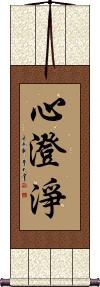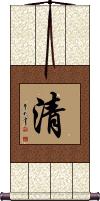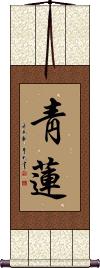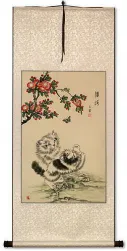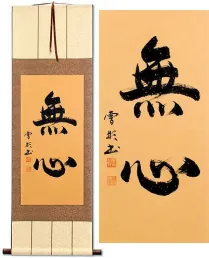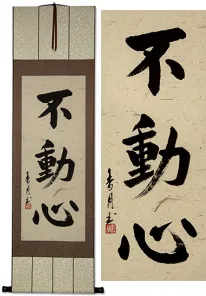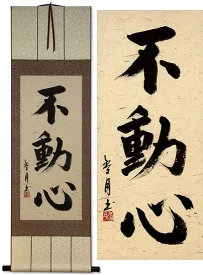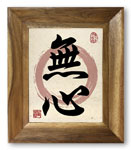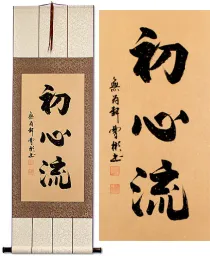Many custom options...
And formats...

Purity of Mind in Chinese / Japanese...
Buy a Purity of Mind calligraphy wall scroll here!
Personalize your custom “Purity of Mind” project by clicking the button next to your favorite “Purity of Mind” title below...
Purity of Mind
心澄淨 is the Buddhist concept of the pure and calm mind. It is believed that once you achieve a meditative state of pure focused thought, the mind becomes clear and calm. Although, others will say this means that achieving a calm mind will allow you to reach pure thought.
From Sanskrit, this is known as citta-prasāda. The concept of citta-prasāda is sometimes defined as “clear heart-mind,” or “the single and definitive aspiration.”
Clarity
清 is a word that means clarity or clear in Chinese, Japanese Kanji, and old Korean Hanja.
Looking at the parts of this character, you have three splashes of water on the left, “life” on the top right, and the moon on the lower right.
Because of something Confucius said about 2500 years ago, you can imagine that this character means “live life with clarity like bright moonlight piercing pure water.” The Confucian idea is something like “Keep clear what is pure in yourself, and let your pure nature show through.” Kind of like saying, “Don't pollute your mind or body, so that they remain clear.”
This might be stretching the definition of this single Chinese character but the elements are there, and “clarity” is a powerful idea.
Korean note: Korean pronunciation is given above but this character is written with a slight difference in the "moon radical" in Korean. However, anyone who can read Korean Hanja, will understand this character with no problem (this is considered an alternate form in Korean). If you want the more standard Korean Hanja form (which is an alternate form in Chinese), just let me know.
Japanese note: When reading in Japanese, this Kanji has additional meanings of pure, purify, or cleanse (sometimes to remove demons or "exorcise"). Used more in compound words in Japanese than as a stand-alone Kanji.
Blue Lotus
靑蓮 is a common title for Blue Lotus.
靑蓮 is often used in a Buddhist context for blue lotus from the Sanskrit “utpala.” This often refers to the clarity and purity of the lotus blue eyes possessed by a Living Buddha. It can also represent the purity of mind (without desire, suffering, fear, etc.).
This in-stock artwork might be what you are looking for, and ships right away...
Gallery Price: $144.00
Your Price: $79.88
Gallery Price: $200.00
Your Price: $118.88
Gallery Price: $200.00
Your Price: $118.88
Gallery Price: $202.00
Your Price: $111.88
Gallery Price: $106.00
Your Price: $58.88
Gallery Price: $79.00
Your Price: $43.88
Gallery Price: $198.00
Your Price: $109.88
Gallery Price: $60.00
Your Price: $36.88
Gallery Price: $108.00
Your Price: $59.88
Gallery Price: $60.00
Your Price: $39.88
Not the results for Purity of Mind that you were looking for?
Below are some entries from our dictionary that may match your Purity of Mind search...
| Characters If shown, 2nd row is Simp. Chinese |
Pronunciation Romanization |
Simple Dictionary Definition |
心澄淨 see styles |
xīn chéng jìng xin1 cheng2 jing4 hsin ch`eng ching hsin cheng ching shin chōjō |
More info & calligraphy: Purity of Mind |
三身 see styles |
sān shēn san1 shen1 san shen sanmi さんみ |
{Buddh} trikaya (three bodies of the Buddha); (surname) Sanmi trikāya. 三寶身 The threefold body or nature of a Buddha, i.e. the 法, 報, and 化身, or dharmakāya, sambhogakāya, and nirmāṇakāya. The three are defined as 自性, 受用, and 變化, the Buddha-body per se, or in its essential nature; his body of bliss, which he "receives" for his own "use" and enjoyment; and his body of transformation, by which he can appear in any form; i.e. spiritual, or essential; glorified; revealed. While the doctrine of the trikāya is a Mahāyāna concept, it partly results from the Hīnayāna idealization of the earthly Buddha with his thirty-two signs, eighty physical marks, clairvoyance, clairaudience, holiness, purity, wisdom, pity, etc. Mahāyāna, however, proceeded to conceive of Buddha as the Universal, the All, with infinity of forms, yet above all our concepts of unity or diversity. To every Buddha Mahāyāna attributed a three-fold body: that of essential Buddha; that of joy or enjoyment of the fruits of his past saving labours; that of power to transform himself at will to any shape for omnipresent salvation of those who need him. The trinity finds different methods of expression, e.g. Vairocana is entitled 法身, the embodiment of the Law, shining everywhere, enlightening all; Locana is 報身; c.f. 三賓, the embodiment of purity and bliss; Śākyamuni is 化身 or Buddha revealed. In the esoteric sect they are 法 Vairocana, 報 Amitābha, and 化 Śākyamuni. The 三賓 are also 法 dharma, 報 saṅgha, 化 buddha. Nevertheless, the three are considered as a trinity, the three being essentially one, each in the other. (1) 法身 Dharmakāya in its earliest conception was that of the body of the dharma, or truth, as preached by Śākyamuni; later it became his mind or soul in contrast with his material body. In Mādhyamika, the dharmakāya was the only reality, i.e. the void, or the immateria1, the ground of all phenomena; in other words, the 眞如 the tathāgatagarbha, the bhūtatathatā. According to the Huayan (Kegon) School it is the 理or noumenon, while the other two are氣or phenomenal aspects. "For the Vijñānavāda... the body of the law as highest reality is the void intelligence, whose infection (saṃkleҫa) results in the process of birth and death, whilst its purification brings about Nirvāṇa, or its restoration to its primitive transparence" (Keith). The "body of the law is the true reality of everything". Nevertheless, in Mahāyāna every Buddha has his own 法身; e.g. in the dharmakāya aspect we have the designation Amitābha, who in his saṃbhogakāya aspect is styled Amitāyus. (2) 報身Sambhogakāya, a Buddha's reward body, or body of enjoyment of the merits he attained as a bodhisattva; in other words, a Buddha in glory in his heaven. This is the form of Buddha as an object of worship. It is defined in two aspects, (a) 自受用身 for his own bliss, and (b) 他受用身 for the sake of others, revealing himself in his glory to bodhisattvas, enlightening and inspiring them. By wisdom a Buddha's dharmakāya is attained, by bodhisattva-merits his saṃbhogakāya. Not only has every Buddha all the three bodies or aspects, but as all men are of the same essence, or nature, as Buddhas, they are therefore potential Buddhas and are in and of the trikāya. Moreover, trikāya is not divided, for a Buddha in his 化身 is still one with his 法身 and 報身, all three bodies being co-existent. (3) 化身; 應身; 應化身 nirmāṇakāya, a Buddha's transformation, or miraculous body, in which he appears at will and in any form outside his heaven, e.g. as Śākyamuni among men. |
十妙 see styles |
shí miào shi2 miao4 shih miao jūmyō |
The ten wonders, or incomprehensibles; there are two groups, the 迹v traceable or manifested and 本門妙 the fundamental. The 迹門十妙 are the wonder of: (1) 境妙 the universe, sphere, or whole, embracing mind, Buddha, and all things as a unity; (2) 智妙 a Buddha's all-embracing knowledge arising from such universe; (3) 行妙 his deeds, expressive of his wisdom; (4) 位妙 his attainment of all the various Buddha stages, i.e. 十住 and十地; (5) 三法妙 his three laws of 理, 慧, and truth, wisdom, and vision; (6) 感應妙 his response to appeal, i.e. his (spiritual) response or relation to humanity, for "all beings are my children"; (7) 神通妙 his supernatural powers; (8) 說法妙 his preaching; (9) 眷屬妙 his supernatural retinue; (10) 利益妙 the blessings derived through universal elevation into Buddhahood. The 本門十妙 are the wonder of (1) 本因妙 the initial impulse or causative stage of Buddhahood; (2) 本果妙 its fruit or result in eternity, joy, and purity; (3) 國土妙 his (Buddha) realm; (4) 感應妙 his response (to human needs); (5) 神通妙 his supernatural powers; (6) 說法妙 his preaching; (7) 眷屬妙 his supernatural retinue; (8) 涅槃妙 his nirvāṇa; (9) 壽命妙 his (eternal) life; (10) his blessings as above. Both groups are further defined as progressive stages in a Buddha's career. These "wonders" are derived from the Lotus sūtra. |
四禪 四禅 see styles |
sì chán si4 chan2 ssu ch`an ssu chan shizen |
(四禪天) The four dhyāna heavens, 四靜慮 (四靜慮天), i. e. the division of the eighteen brahmalokas into four dhyānas: the disciple attains to one of these heavens according to the dhyāna he observes: (1) 初禪天 The first region, 'as large as one whole universe' comprises the three heavens, Brahma-pāriṣadya, Brahma-purohita, and Mahābrahma, 梵輔, 梵衆, and 大梵天; the inhabitants are without gustatory or olfactory organs, not needing food, but possess the other four of the six organs. (2) 二禪天 The second region, equal to 'a small chiliocosmos' 小千界, comprises the three heavens, according to Eitel, 'Parīttābha, Apramāṇābha, and Ābhāsvara, ' i. e. 少光 minor light, 無量光 infinite light, and 極光淨 utmost light purity; the inhabitants have ceased to require the five physical organs, possessing only the organ of mind. (3) 三禪天 The third region, equal to 'a middling chiliocosmos '中千界, comprises three heavens; Eitel gives them as Parīttaśubha, Apramāṇaśubha, and Śubhakṛtsna, i. e. 少淨 minor purity, 無量淨 infinite purity, and 徧淨 universal purity; the inhabitants still have the organ of mind and are receptive of great joy. (4) 四禪天 The fourth region, equal to a great chiliocosmos, 大千界, comprises the remaining nine brahmalokas, namely, Puṇyaprasava, Anabhraka, Bṛhatphala, Asañjñisattva, Avṛha, Atapa, Sudṛśa, Sudarśana, and Akaniṣṭha (Eitel). The Chinese titles are 福生 felicitous birth, 無雲 cloudless, 廣果 large fruitage, 無煩 no vexations, atapa is 無熱 no heat, sudṛśa is 善見 beautiful to see, sudarśana is 善現 beautiful appearing, two others are 色究竟 the end of form, and 無想天 the heaven above thought, but it is difficult to trace avṛha and akaniṣṭha; the inhabitants of this fourth region still have mind. The number of the dhyāna heavens differs; the Sarvāstivādins say 16, the 經 or Sutra school 17, and the Sthavirāḥ school 18. Eitel points out that the first dhyāna has one world with one moon, one mem, four continents, and six devalokas; the second dhyāna has 1, 000 times the worlds of the first; the third has 1, 000 times the worlds of the second; the fourth dhyāna has 1, 000 times those of the third. Within a kalpa of destruction 壞劫 the first is destroyed fifty-six times by fire, the second seven by water, the third once by wind, the fourth 'corresponding to a state of absolute indifference' remains 'untouched' by all the other evolutions; when 'fate (天命) comes to an end then the fourth dhyāna may come to an end too, but not sooner'. |
始覺 始觉 see styles |
shǐ jué shi3 jue2 shih chüeh shigaku |
The initial functioning of mind or intelligence as a process of 'becoming', arising from 本覺 which is Mind or Intelligence, self-contained, unsullied, and considered as universal, the source of all enlightenment. The 'initial intelligence' or enlightenment arises from the inner influence 薰 of the Mind and from external teaching. In the 'original intelligence' are the four values adopted and made transcendent by the Nirvāṇa-sūtra, viz. 常, 樂, 我, 淨 Perpetuity, joy, personality, and purity; these are acquired through the 始覺 process of enlightenment. Cf. 起信論 Awakening of Faith. |
心淨 see styles |
xīn jìng xin1 jing4 hsin ching shinjō |
purity of mind |
心蓮 心莲 see styles |
xīn lián xin1 lian2 hsin lien Shinren |
The lotus of the mind or heart; the exoteric school interprets it by original purity; the esoteric by the physical heart, which resembles a closed lotus with eight petals. |
沙門 沙门 see styles |
shā mén sha1 men2 sha men shamon しゃもん |
monk (Sanskrit: Sramana, originally refers to north India); Buddhist monk {Buddh} shramana (wandering monk); (surname) Shamon śramaṇa. 桑門; 娑門; 喪門; 沙門那; 舍羅磨拏; 沙迦懣曩; 室摩那拏 (1) Ascetics of all kinds; 'the Sarmanai, or Samanaioi, or Germanai of the Greeks, perhaps identical also with the Tungusian Saman or Shaman.' Eitel. (2) Buddhist monks 'who 'have left their families and quitted the passions', the Semnoi of the Greeks'. Eitel. Explained by 功勞 toilful achievement, 勤息 diligent quieting (of the mind and the passions), 淨志 purity of mind, 貧道 poverty. 'He must keep well the Truth, guard well every uprising (of desire), be uncontaminated by outward attractions, be merciful to all and impure to none, be not elated to joy nor harrowed by distress, and able to bear whatever may come.' The Sanskrit root is śram, to make effort; exert oneself, do austerities. |
法性 see styles |
fǎ xìng fa3 xing4 fa hsing hosshou / hossho ほっしょう |
{Buddh} (See 法相・ほっそう・1) dharmata (dharma nature, the true nature of all manifest phenomena); (personal name) Hosshou dharmatā. Dharma-nature, the nature underlying all thing, the bhūtatathatā, a Mahāyāna philosophical concept unknown in Hīnayāna, v. 眞如 and its various definitions in the 法相, 三論 (or法性), 華嚴, and 天台 Schools. It is discussed both in its absolute and relative senses, or static and dynamic. In the Mahāparinirvāṇa sūtra and various śāstras the term has numerous alternative forms, which may be taken as definitions, i. e. 法定 inherent dharma, or Buddha-nature; 法住 abiding dharma-nature; 法界 dharmakṣetra, realm of dharma; 法身 dharmakāya, embodiment of dharma; 實際 region of reality; 實相 reality; 空性 nature of the Void, i. e. immaterial nature; 佛性 Buddha-nature; 無相 appearance of nothingness, or immateriality; 眞如 bhūtatathatā; 如來藏 tathāgatagarbha; 平等性 universal nature; 離生性 immortal nature; 無我性 impersonal nature; 虛定界: realm of abstraction; 不虛妄性 nature of no illusion; 不變異性 immutable nature; 不思議界 realm beyond thought; 自性淸淨心 mind of absolute purity, or unsulliedness, etc. Of these the terms 眞如, 法性, and 實際 are most used by the Prajñāpāramitā sūtras. |
七最勝 七最胜 see styles |
qī zuì shèng qi1 zui4 sheng4 ch`i tsui sheng chi tsui sheng shichi saishō |
The seven perfections, see唯識論, 9. 安住最勝 Perfect rest in the bodhisattva nature. 依止最勝 perfect reliance on, or holding fast to the great bodhi (awakened mind). 意果最勝 perfect resultant aim in-pity for all 事業最勝 Perfect in constant performance. 巧便最勝 Perfect in able device (for spiritual presentation). 廻向最勝 Perfect direction towards the highest bodhi. 滿淨最勝 Perfect purity and peace. |
八解脫 八解脱 see styles |
bā jiě tuō ba1 jie3 tuo1 pa chieh t`o pa chieh to hachi gedatsu |
aṣṭa-vimokṣa, mokṣa, vimukti, mukti. Liberation, deliverance, freedom, emancipation, escape, release―in eight forms; also 八背捨 and cf. 解脫 and 八勝處. The eight are stages of mental concentration: (1) 内有色想觀外色解脱 Liberation, when subjective desire arises, by examination of the object, or of all things and realization of their filthiness. (2) 内無色想觀外色解脫 Liberation, when no subjective desire arises, by still meditating as above. These two are deliverance by meditation on impurity, the next on purity. (3) 淨身作證具足住解脫 Liberation by concentration on the pure to the realization of a permanent state of freedom from all desire. The above three "correspond to the four Dhyānas". (Eitel.) (4) 空無邊處解脫 Liberation in realization of the infinity of space, or the immaterial. (5) 識無邊處解脫 Liberation in realization of infinite knowledge. (6) 無所有處解脫Liberation in realization of nothingness, or nowhereness. (7) 非想非非想處解脫 Liberation in the state of mind where there is neither thought nor absence of thought. These four arise out of abstract meditation in regard to desire and form, and are associated with the 四空天. (8) 滅受 想定解脫 Liberation by means of a state of mind in which there is final extinction, nirvāṇa, of both sensation, vedanā, and consciousness, saṁjñā. |
六染心 see styles |
liù rǎn xīn liu4 ran3 xin1 liu jan hsin roku zenshin |
The six mental 'taints' of the Awakening of Faith 起心論. Though mind-essence is by nature pure and without stain, the condition of 無明 ignorance, or innocence, permits of taint or defilement corresponding to the following six phases: (1) 執相應染 the taint interrelated to attachment, or holding the seeming for the real; it is the state of 執取相 and 名字相 which is cut off in the final pratyeka and śrāvaka stage and the bodhisattva 十住 of faith; (2) 不斷相應染 the taint interrelated to the persisting attraction of the causes of pain and pleasure; it is the 相續相 finally eradicated in the bodhisattva 初地 stage of purity; (3) 分別智相應染 the taint interrelated to the 'particularizing intelligence' which discerns things within and without this world; it is the first 智相, cut off in the bodhisattva 七地 stage of spirituality; (4) 現色不相應染 the non-interrelated or primary taint, i. e. of the 'ignorant' mind as yet hardly discerning subject from object, of accepting an external world; the third 現相 cut of in the bodhisattva 八地 stage of emancipation from the material; (5) 能見心不相應染 the non-interrelated or primary taint of accepting a perceptive mind, the second 轉相, cut of in the bodhisattva 九地 of intuition, or emancipation from mental effort; (6) 根本業不相應染 the non-interrelated or primary taint of accepting the idea of primal action or activity in the absolute; it is the first 業相, and cut of in the 十地 highest bodhisattva stage, entering on Buddhahood. See Suzuki's translation, 80-1. |
四念處 四念处 see styles |
sì niàn chù si4 nian4 chu4 ssu nien ch`u ssu nien chu shinenjo |
Four objects on which memory or the thought should dwell— the impurity of the body, that all sensations lead to suffering, that mind is impermanent, and that there is no such thing as an ego. There are other categories for thought or meditation.; (四念處觀); 四念住 smṛtyupasthāna. The fourfold stage of mindfulness, thought, or meditation that follows the 五停心觀 five-fold procedure for quieting the mind. This fourfold method, or objectivity of thought, is for stimulating the mind in ethical wisdom. It consists of contemplating (1) 身 the body as impure and utterly filthy; (2) 受 sensation, or consciousness, as always resulting in suffering; (3) 心 mind as impermanent, merely one sensation after another; (4) 法 things in general as being dependent and without a nature of their own. The four negate the ideas of permanence, joy, personality, and purity 常, 樂, 我, and 淨, i. e. the four 顚倒, but v. 四德. They are further subdivided into 別 and 總 particular and general, termed 別相念處 and 總相念處, and there are further subdivisions. |
心淸淨 see styles |
xīn qīng jìng xin1 qing1 jing4 hsin ch`ing ching hsin ching ching shin shōjō |
mind's (original) purity |
胎藏界 see styles |
tāi zàng jiè tai1 zang4 jie4 t`ai tsang chieh tai tsang chieh taizō kai |
Garbhadhātu, or Garbhakośa-(dhātu), the womb treasury, the universal source from which all things are produced; the matrix; the embryo; likened to a womb in which all of a child is conceived— its body, mind, etc. It is container and content; it covers and nourishes; and is the source of all supply. It represents the 理性 fundamental nature, both material elements and pure bodhi, or wisdom in essence or purity; 理 being the garbhadhātu as fundamental wisdom, and 智 acquired wisdom or knowledge, the vajradhātu. It also represents the human heart in its innocence or pristine purity, which is considered as the source of all Buddha-pity and moral knowledge. And it indicates that from the central being in the maṇḍala, viz. the Sun as symbol of Vairocana, there issue all the other manifestations of wisdom and power, Buddhas, bodhisattvas, demons, etc. It is 本覺 original intellect, or the static intellectuality, in contrast with 始覺 intellection, the initial or dynamic intellectuality represented in the vajradhātu; hence it is the 因 cause and vajradhātu the 果 effect; though as both are a unity, the reverse may be the rule, the effect being also the cause; it is also likened to 利他 enriching others, as vajradhātu is to 自利 enriching self. Kōbō Daishi, founder of the Yoga or Shingon 眞言 School in Japan, adopted the representation of the ideas in maṇḍalas, or diagrams, as the best way of revealing the mystic doctrine to the ignorant. The garbhadhātu is the womb or treasury of all things, the universe; the 理 fundamental principle, the source; its symbols are a triangle on its base, and an open lotus as representing the sun and Vairocana. In Japan this maṇḍala is placed on the east, typifying the rising sun as source, or 理. The vajradhātu is placed west and represents 智 wisdom or knowledge as derived from 理 the underlying principle, but the two are essential one to the other, neither existing apart. The material and spiritual; wisdom-source and intelligence; essence and substance; and similar complementary ideas are thus portrayed; the garbhadhātu may be generally considered as the static and the vajradhātu as the dynamic categories, which are nevertheless a unity. The garbhadhātu is divided into 三部 three sections representing samādhi or quiescence, wisdom-store, and pity-store, or thought, knowledge, pity; one is called the Buddha-section, the others the Vajra and Lotus sections respectively; the three also typify vimokṣa, prajñā, and dharmakāya, or freedom, understanding, and spirituality. There are three heads of these sections, i. e. Vairocana, Vajrapāṇi, and Avalokiteśvara; each has a mother or source, e. g. Vairocana from Buddha's-eye; and each has a 明王 or emanation of protection against evil; also a śakti or female energy; a germ-letter, etc. The diagram of five Buddhas contains also four bodhisattvas, making nine in all, and there are altogether thirteen 大院 or great courts of various types of ideas, of varying numbers, generally spoken of as 414. Cf. 金剛界; 大日; 兩部. |
三種淸淨 三种淸淨 see styles |
sān zhǒng qīng jìng san1 zhong3 qing1 jing4 san chung ch`ing ching san chung ching ching sanshu shōjō |
The three purities of a bodhisattva— a mind free from all impurity, a body pure because never to be reborn save by transformation, an appearance 相 perfectly pure and adorned. |
九種大禪 九种大禅 see styles |
jiǔ zhǒng dà chán jiu3 zhong3 da4 chan2 chiu chung ta ch`an chiu chung ta chan kushu daizen |
The nine kinds of Mahāyāna dhyāna for bodhisattvas, given in the 菩薩地持經 6 and in other works; they are associated with the patience 忍 pāramitā and with the dhyāna of the super-realms. The nine are meditations: (1) 自性禪 on the original nature of things, or mind as the real nature, from which all things derive; (2) 一切禪 on achieving the development of self and all others to the utmost; (3) 難禪 on the difficulties of certain dhyāna conditions; (4) 一切禪 on the entrance to all the (superior) dhyāna conditions; (5) 善人禪 on the good; (6) 一切行禪 on all Mahāyāna practices and actions; (7) 除煩惱禪 on ridding all sufferers from the miseries of passion and delusion; (8) 此世他世樂禪 on the way to bring joy to all people both in this life and hereafter; (9) 淸淨淨禪 on perfect purity in the termination of all delusion and distress and the obtaining of perfect enlightenment. |
十不二門 十不二门 see styles |
shí bù èr mén shi2 bu4 er4 men2 shih pu erh men jū funi mon |
The school of the ten pairs of unified opposites founded by Jingxi 荊溪 on the teaching of the Lotus sūtra. There are several books bearing the name. The unifying principle is that of the identity of contraries, and the ten apparent contraries are matter and mind, internal and external, 修證 practice and proof (or realization), cause and effect, impurity and purity, objective and subjective, self and other, 三業 action, speech, and thought, 權實 relative and absolute, the fertilized and the fertilizer (i.e. receiver and giver). There are several treatises on the subject in the Canon. |
The following table may be helpful for those studying Chinese or Japanese...
| Title | Characters | Romaji (Romanized Japanese) | Various forms of Romanized Chinese | |
| Purity of Mind | 心澄淨 | shin chou jou shinchoujou shin cho jo | xīn chéng jìng xin1 cheng2 jing4 xin cheng jing xinchengjing | hsin ch`eng ching hsinchengching hsin cheng ching |
| Clarity | 清 | sei | qīng / qing1 / qing | ch`ing / ching |
| Blue Lotus | 靑蓮 靑莲 | seiren | qing lián / qing lian2 / qing lian / qinglian | ch`ing lien / chinglien / ching lien |
| In some entries above you will see that characters have different versions above and below a line. In these cases, the characters above the line are Traditional Chinese, while the ones below are Simplified Chinese. | ||||
Successful Chinese Character and Japanese Kanji calligraphy searches within the last few hours...
